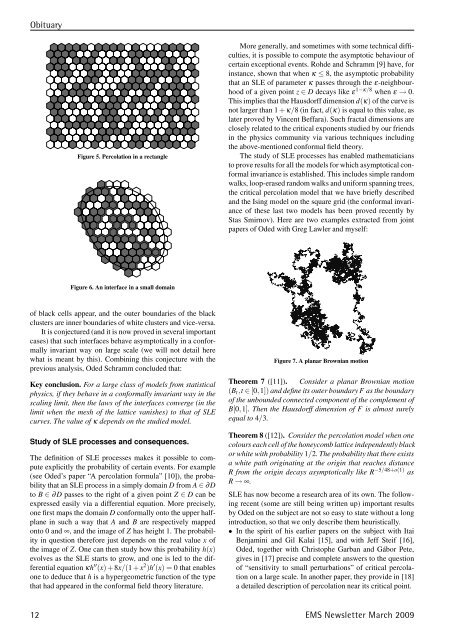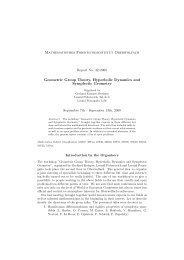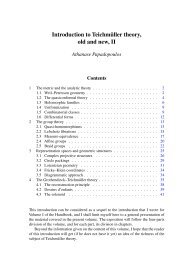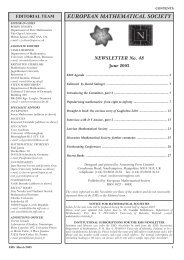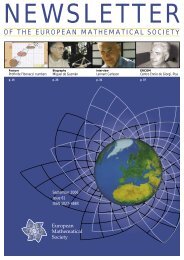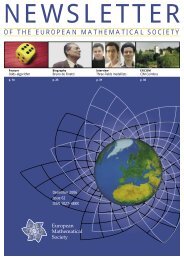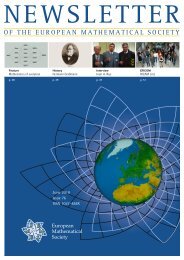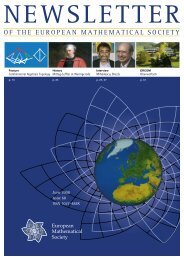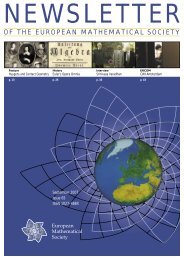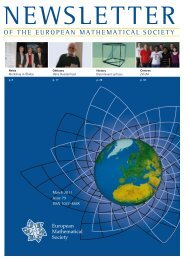New from Springer - European Mathematical Society Publishing ...
New from Springer - European Mathematical Society Publishing ...
New from Springer - European Mathematical Society Publishing ...
You also want an ePaper? Increase the reach of your titles
YUMPU automatically turns print PDFs into web optimized ePapers that Google loves.
Obituary<br />
Figure 5. Percolation in a rectangle<br />
Figure 6. An interface in a small domain<br />
of black cells appear, and the outer boundaries of the black<br />
clusters are inner boundaries of white clusters and vice-versa.<br />
It is conjectured (and it is now proved in several important<br />
cases) that such interfaces behave asymptotically in a conformally<br />
invariant way on large scale (we will not detail here<br />
what is meant by this). Combining this conjecture with the<br />
previous analysis, Oded Schramm concluded that:<br />
Key conclusion. For a large class of models <strong>from</strong> statistical<br />
physics, if they behave in a conformally invariant way in the<br />
scaling limit, then the laws of the interfaces converge (in the<br />
limit when the mesh of the lattice vanishes) to that of SLE<br />
curves. The value of κ depends on the studied model.<br />
Study of SLE processes and consequences.<br />
The definition of SLE processes makes it possible to compute<br />
explicitly the probability of certain events. For example<br />
(see Oded’s paper “A percolation formula” [10]), the probability<br />
that an SLE process in a simply domain D <strong>from</strong> A ∈ ∂D<br />
to B ∈ ∂D passes to the right of a given point Z ∈ D can be<br />
expressed easily via a differential equation. More precisely,<br />
one first maps the domain D conformally onto the upper halfplane<br />
in such a way that A and B are respectively mapped<br />
onto 0 and ∞, and the image of Z has height 1. The probability<br />
in question therefore just depends on the real value x of<br />
the image of Z. One can then study how this probability h(x)<br />
evolves as the SLE starts to grow, and one is led to the differential<br />
equation κh ′′ (x)+8x/(1 + x 2 )h ′ (x)=0 that enables<br />
one to deduce that h is a hypergeometric function of the type<br />
that had appeared in the conformal field theory literature.<br />
More generally, and sometimes with some technical difficulties,<br />
it is possible to compute the asymptotic behaviour of<br />
certain exceptional events. Rohde and Schramm [9] have, for<br />
instance, shown that when κ ≤ 8, the asymptotic probability<br />
that an SLE of parameter κ passes through the ε-neighbourhood<br />
of a given point z ∈ D decays like ε 1−κ/8 when ε → 0.<br />
This implies that the Hausdorff dimension d(κ) of the curve is<br />
not larger than 1 + κ/8 (in fact, d(κ) is equal to this value, as<br />
later proved by Vincent Beffara). Such fractal dimensions are<br />
closely related to the critical exponents studied by our friends<br />
in the physics community via various techniques including<br />
the above-mentioned conformal field theory.<br />
The study of SLE processes has enabled mathematicians<br />
to prove results for all the models for which asymptotical conformal<br />
invariance is established. This includes simple random<br />
walks, loop-erased random walks and uniform spanning trees,<br />
the critical percolation model that we have briefly described<br />
and the Ising model on the square grid (the conformal invariance<br />
of these last two models has been proved recently by<br />
Stas Smirnov). Here are two examples extracted <strong>from</strong> joint<br />
papers of Oded with Greg Lawler and myself:<br />
Figure 7. A planar Brownian motion<br />
Theorem 7 ([11]). Consider a planar Brownian motion<br />
(Bt,t ∈ [0,1]) and define its outer boundary F as the boundary<br />
of the unbounded connected component of the complement of<br />
B[0,1]. Then the Hausdorff dimension of F is almost surely<br />
equal to 4/3.<br />
Theorem 8 ([12]). Consider the percolation model when one<br />
colours each cell of the honeycomb lattice independently black<br />
or white with probability 1/2. The probability that there exists<br />
a white path originating at the origin that reaches distance<br />
R <strong>from</strong> the origin decays asymptotically like R −5/48+o(1) as<br />
R → ∞.<br />
SLE has now become a research area of its own. The following<br />
recent (some are still being written up) important results<br />
by Oded on the subject are not so easy to state without a long<br />
introduction, so that we only describe them heuristically.<br />
• In the spirit of his earlier papers on the subject with Itai<br />
Benjamini and Gil Kalai [15], and with Jeff Steif [16],<br />
Oded, together with Christophe Garban and Gábor Pete,<br />
gives in [17] precise and complete answers to the question<br />
of “sensitivity to small perturbations” of critical percolation<br />
on a large scale. In another paper, they provide in [18]<br />
a detailed description of percolation near its critical point.<br />
12 EMS <strong>New</strong>sletter March 2009


